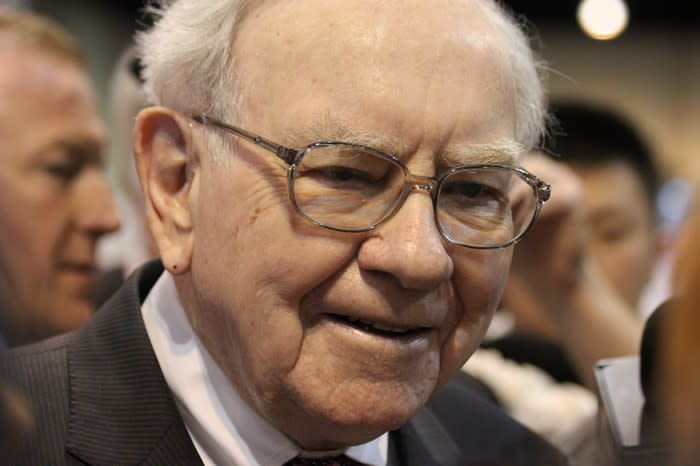Here's What Stocks Buffett's Berkshire Hathaway Bought and Sold in the Second Quarter
In addition to its collection of more than 60 subsidiary businesses, Berkshire Hathaway (NYSE: BRK-A) (NYSE: BRK-B) owns a massive stock portfolio worth more than $200 billion. Since most of the stock positions were hand-picked by legendary investor Warren Buffett himself, it's no surprise that this is one of the most closely watched stock portfolios in the world.
With that in mind, we recently got a glimpse of what Buffett and his team bought and sold during the second quarter. Here's a rundown of all of Berkshire's recent stock moves and what investors need to know about them.

Image source: The Motley Fool.
What Berkshire Hathaway bought during the second quarter
Berkshire didn't initiate any new positions, but it added to four of its existing ones:
Company (Stock Symbol) | Shares Bought in Q2 2019 | Shares Owned at End of Q2 2019 | Market Value of Shares Bought |
|---|---|---|---|
Bank of America (NYSE: BAC) | 31,081,000 | 927,248,600 | $914.4 million |
U.S. Bancorp | 3,150,787 | 132,459,618 | $167.0 million |
Amazon.com (NASDAQ: AMZN) | 54,000 | 537,300 | $103.8 million |
Red Hat | 61,419 | 5,171,890 | $11.7 million |
Total purchases | -- | -- | $1.197 billion |
Data source: Berkshire Hathaway SEC filings. Market values as of June 30, 2019.
First and foremost, notice that Buffett appears to still be bullish on bank stocks. Berkshire has added to several of its bank stock investments in recent quarters, and continued that trend in the first quarter with about $1.1 billion invested between Bank of America and U.S. Bancorp.
To be fair, we already knew about the Bank of America investment. In fact, in a separate SEC filing in late July, Berkshire disclosed ownership of 950 million shares of Bank of America. This means that Berkshire has purchased even more shares of the bank since the quarter ended.
It's also important to realize that the Amazon.com investment was not made by Buffett himself, but was initiated by either Todd Combs or Ted Weschler, Buffett's two stock-pickers.
And finally, although Berkshire bought more Red Hat during the quarter, this was likely viewed as an arbitrage opportunity. Shortly after the end of the quarter, IBM closed on its acquisition of Red Hat for $190 per share. Berkshire likely thought the deal had a high probability of going through and decided to add some shares at a price lower than IBM's acquisition. It's also interesting to note that thanks to IBM's acquisition of Red Hat, Berkshire got nearly $1 billion in cash to add to its ever-growing war chest.
What Berkshire Hathaway sold
On the surface, it appears that Berkshire was a net seller of stocks during the second quarter. Here are the two stocks Berkshire sold, and the important point investors need to know.
Company (Stock Symbol) | Shares Sold in Q2 2019 | Shares Owned at End of Q2 2019 | Market Value of Shares Sold |
|---|---|---|---|
Charter Communications (NASDAQ: CHTR) | 284,102 | 5,426,609 | $113.0 million |
USG | 39,002,016 | 0 | $1.638 billion |
Total dispositions | -- | -- | $1.751 billion |
Data source: Berkshire Hathaway SEC filings. Market values as of June 30, 2019 except USG, which was sold to Knauf in Q2 at $42 per share.
The key point to mention here is that the USG position wasn't exactly sold, at least not in the sense that Buffett decided to get rid of it. During the second quarter, USG was acquired by Knauf, and Berkshire received $42 per share for its stake. So, I'd call the small reduction in Berkshire's Charter Communications investment the only real "sale" during the quarter.
One more "buy"
It's also worth noting that Berkshire also spent a considerable amount of money -- about $400 million -- buying back its own stock, as its second-quarter earnings report revealed. This is a steep decline from the $1.7 billion in buybacks during the first quarter, but still indicates that both Warren Buffett and Charlie Munger think Berkshire is considerably cheaper than its intrinsic value.
(If you're curious, the average price Berkshire paid for its stock was about $201.50 per Class B share during the period.)
Still a shortage of attractive opportunities
The second quarter was Berkshire's least active in terms of stock purchases in recent memory. Over the past few years, Berkshire has struggled to find attractive ways to put its cash to work, which is why the company has more than $122 billion on its balance sheet. Now that we've gotten a glimpse of the company's second-quarter activity, it's clear that this was still the case.
More From The Motley Fool
John Mackey, CEO of Whole Foods Market, an Amazon subsidiary, is a member of The Motley Fool's board of directors. Matthew Frankel, CFP, owns shares of Bank of America and Berkshire Hathaway (B shares). The Motley Fool owns shares of and recommends Amazon and Berkshire Hathaway (B shares). The Motley Fool is short shares of IBM and has the following options: short January 2020 $200 puts on IBM, long January 2021 $200 calls on Berkshire Hathaway (B shares), short January 2021 $200 puts on Berkshire Hathaway (B shares), short September 2019 $145 calls on IBM, and long January 2020 $200 calls on IBM. The Motley Fool has a disclosure policy.
This article was originally published on Fool.com